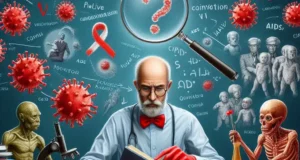If you imagine your DNA as a sacred manuscript—carefully written by generations of biology—then a retrovirus is the ghostwriter that slips in silently and adds new lines without permission. It’s not just a virus; it’s a genetic infiltrator. And among the most infamous of these is HIV, the virus behind AIDS.
But before we dive deeper, let’s return to the burning question asked for decades: “AIDS – where did it come from?”

The answer begins with a virus that behaves unlike most. Retroviruses are a rare class of viruses that carry RNA instead of DNA. But that’s just the beginning of their cleverness. When a retrovirus infects a host, it uses a special enzyme called reverse transcriptase to convert its RNA into DNA. That new viral DNA then inserts itself into the host’s genome, becoming part of the cell’s permanent instructions—like a hacker installing a backdoor in a computer system.
HIV (Human Immunodeficiency Virus) is one such retrovirus. Once inside the body, it doesn’t just attack—it reprograms. It targets the immune system’s CD4 cells, which are like the generals of our body’s defense force. Slowly, methodically, HIV breaks down these commanders, weakening the immune army until it can no longer fight even common infections. That’s when AIDS (Acquired Immunodeficiency Syndrome) emerges—not from the virus directly, but from the body’s inability to defend itself.
But where did this retrovirus come from?
The scientific trail leads us back to Central Africa, to chimpanzees infected with SIV (Simian Immunodeficiency Virus)—a relative of HIV. Through bushmeat hunting, blood contact, and colonial-era medical practices, this viral cousin crossed the species barrier and mutated into HIV-1, the most dominant strain. The leap likely happened in the early 20th century, and from there, it began its quiet spread—carried by travelers, trade routes, and unsterile medical injections.
This is how a retrovirus, small enough to be invisible to the eye, found its way into human history.
So, when we ask “AIDS – where did it come from?”, the answer lies partly in this viral shape-shifter that knows how to live in the shadows of our DNA.
Retroviruses are unique in their ability to stay hidden, embedding themselves into the very blueprint of life. Unlike other viruses that might come and go, retroviruses become part of us. In fact, scientists have discovered that around 8% of the human genome is made up of ancient retroviral DNA—remnants of past infections. But HIV is not ancient. It is recent, real, and still evolving.
Its stealth and persistence made it difficult to detect in the early stages. For decades, it moved silently, building momentum in cities like Kinshasa, amplified by colonial infrastructure and medical neglect. By the time AIDS was identified in the early 1980s, the retrovirus had already spread globally.
So, if you’re still wondering, “AIDS – where did it come from?”—look not just to the forests of Africa, but to the microscopic genius of a retrovirus that cracked the code of human immunity. It came from an ancient mechanism used by nature, weaponized by time and circumstance.

And yet, in understanding HIV’s identity as a retrovirus, we’ve also found ways to fight back. Antiretroviral therapy (ART) doesn’t erase the virus, but it stops it from replicating—silencing its genetic whispers. Today, millions live full lives with HIV because we finally learned how this retrovirus operates.
The story of AIDS is the story of a retrovirus that rewrote the script—in our cells, in our science, and in our societies. But with knowledge, we can begin writing a new chapter—one of awareness, resilience, and healing.




